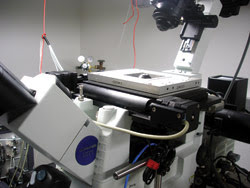New techniques require high precision with minuscule scanning dimensions.
Dr. William O'Brien, Mad City Labs Inc.
In several research applications, such as molecular spectroscopy and Förster resonance energy transfer (FRET), long-range motion is used to zoom in on a specific area of interest so that it can be studied at the nanometer scale. In drug discovery applications that use multiwell plates, long-range motion accesses the different wells, and chemical analysis in each well requires nanometer precision.
Three-dimensional nanometer-scale lithography also requires highly precise registry over many millimeters. The common thread is that each of these applications must have a combination of long-range motion with nanometer resolution, and would benefit from full automation. However, potential solutions are not without challenges.
Techniques used to achieve nanometer precision — such as flexure-guided motion, piezoactuators and piezoresistive position sensors — present their own challenges. First, they work best at travel ranges below a few hundred microns. Flexure-guidance systems are unique in that they have no parts in contact that move relative to each other. Thus, when properly designed, a flexure-guided system has no hysteresis or out-of-plane motion. The drawback of flexure guidance is that the range of motion is typically limited to hundreds of microns because of the fatigue limit of the flexure material.
Piezoactuators are important for obtaining nanometer precision because they have a nearly infinitesimal step size, but they are limited to a few hundred microns of motion. Piezoresistive position sensors are necessary for achieving nanometer precision because of their inherent noise level of 0.03 nm or less. However, the minimum step size that a piezoresistive sensor can detect depends on the precision of the digital-to-analog converter used to control the system and its motion range. For example, with a 20-bit converter, the step size corresponding to one bit is 0.09 nm for a 100-μm range but increases to 28 nm for a 30-mm range.
The techniques used in long-range scanning systems — including bearing stages, stepper motors and linear encoders — are very much different from those designed for achieving nanometer precision.
Cross or roller-type bearing guidance systems can be made to have arbitrarily long scanning ranges. However, the balls or rollers change contact points in a nonreproducible manner, which leads to parasitic motions in directions that are perpendicular to the travel direction, typically on the order of microns to tens of microns.
Stepping into position
Stepper motors also can be made to have an arbitrarily long travel range, but even when microstepped, they move in discrete jumps with an associated settling time. When microstepped, the step size can be reduced to tens of nanometers, but these nonreproducible steps often are arbitrarily skipped and later bunched together into a larger step.
Scale encoders are produced by the formation of periodic lines on a glass substrate. A light source placed slightly above the surface of the glass scale creates a diffraction pattern. As the light is moved relative to the glass scale, the diffraction pattern intensity changes sinusoidally, with a period equal to the line spacing. Interpolation of the diffraction intensity is used to locate the position, and resolution of one part in 4000 of the line spacing can be achieved. Periodic errors in the interpolation result in positioning errors on the order of one part in 1000, but they are typically repeatable.
There are a number of difficulties in making a scanning system with both nanometer precision and long-range motion. However, one straightforward but highly useful solution is to combine a nanometer-level precision stage with a long-range motion stage. The Nano-View from Mad City Labs Inc. consists of a stage driven by a two-axis stepper motor and a three-axis low-profile nanopositioning stage.
The stepper motor stage has integrated glass scale encoders with a resolution of 5 nm, stepper motors with a minimal step size of 25 nm and a travel range of 30 × 30 mm. It has a repeatability of 50 nm, which results from parasitic errors in the bearing systems. The nanopositioning stage has integrated piezoresistive sensors with subnanometer resolution and a 200-μm range of motion in each axis.
The stepper motor stage is used for coarse positioning. Once an area of interest is found, this stage locks in place and the nanopositioning stage scans in three dimensions. Both the stepper motor and nano-positioning stages are controlled through a USB interface, which enables simultaneous access to the positions of both the encoder and the nanopositioner. This permits nanometer resolution with a 50-nm registry error over a 30 × 30-mm field of view.

In this experimental setup, the microfluidic mixer allows observation of conformational changes. Courtesy of Xavier Michalet, UCLA.
This combined system has been used to observe fast protein-folding kinetics and other reactions with a mixing time of 8 μs and a sample concentration of femtomoles.1 A microfluidic mixer developed by researchers at Stanford University, Lawrence Livermore National Laboratory and the University of California, Los Angeles, allows access to conformational changes under conditions far from equilibrium and at previously inaccessible time scales. Such a combined system can satisfy the positioning requirements of most experiments that require long-range motion and nanometer-level precision.
Reference
1. D.E. Hertzog et al (2004). Femtomole mixer for microsecond kinetic studies of protein folding. ANALYTICAL CHEMISTRY, pp. 7169-7178.
Meet the author
William O’Brien is a member of the research and development group at Mad City Labs Inc. in Madison, Wis.; e-mail: [email protected].